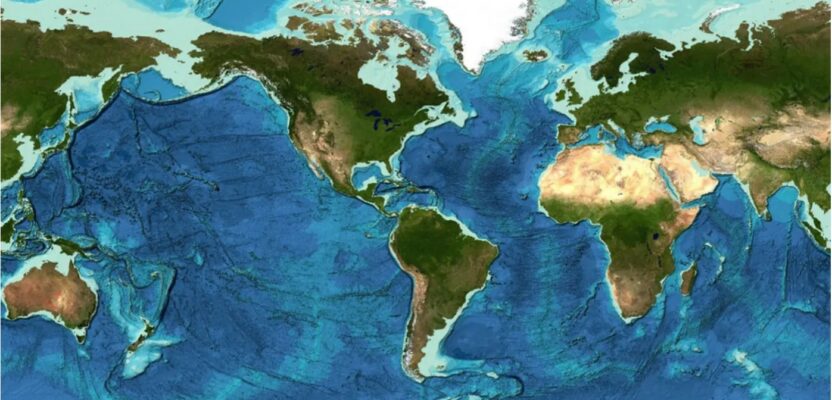More than 23 percent of the ocean seabed is now mapped
Seabed 2030 is a partnership between the Nippon Foundation and the General Bathymetric Chart of the Oceans (GEBCO) and aims to map the entire planet’s seabed by 2030. To date, the project has mapped around 23.4 percent of the seabed. The latest data was announced at the UN Ocean Conference in Lisbon by Nippon Foundation executive director Mitsuyuki Unno.
“In just five years Seabed 2030 has led the way in ocean mapping to achieve 23.4 percent of the seafloor mapped to a high resolution,” he said. “Despite covering over 70 percent of the planet, our knowledge of what lies beneath the blue surface has been severely limited. Without this crucial information we cannot possibly set about having a sustainable future—a complete map of the ocean floor is the missing tool that will enable us to tackle some of the most pressing environmental challenges of our time, including climate change and marine pollution. It will enable us to safeguard the planet’s future.”
A complete map of the seabed is needed for a host of reasons, not least for the future of humanity. The ocean drives global systems that make Earth habitable for us—oxygen, drinking water, much of our food, and the climate are ultimately regulated and provided by the sea. Ocean floor topography also helps identify underwater hazards and inform sustainable marine resource management and infrastructure development.
Seabed 2030 project director Jamie McMichael-Phillips welcomed the data increase: “It is encouraging to see this growth in bathymetric data despite the challenges facing ocean mapping, which were undeniably exacerbated by the pandemic…The progress we have made since 2017 is commendable, but we are mindful of the task still ahead—and eager to realize it.”
The Ocean Decade, of which Seabed 2030 is a flagship program, is a major initiative by the UN to mobilize governments, the private sector, scientists, and civil society to co-design and co-deliver transformative knowledge-led actions to reverse the decline in the health of the ocean and make a change in the sustainable management of the marine environment. IOC-UNESCO is the UN body tasked with leading the implementation of the Ocean Decade.
“The Ocean Decade is about closing the persistent knowledge gaps we face in the ocean community once and for all, because we cannot manage what we cannot measure,” said Ariel Troisi, chair of IOC-UNESCO. “Mapping the seafloor is at the basis of this effort. The sine qua non for creating fail-safe, inclusive, and protective mechanisms for sustainable cohabitation between society and nature within the deep ocean—our last frontier.”
Seabed 2030 also announced a major new partnership with the United States’ National Oceanic and Atmospheric Administration (NOAA). Seabed 2030 actively seeks partnerships to collate all existing data into the definitive GEBCO map, and to identify areas where there are no data to inform future mapping expeditions.
NOAA’s mission is to understand and predict our changing environment, from the deep sea to outer space, and to manage and conserve U.S. coastal and marine resources. The agency is part of the U.S. Department of Commerce, and holds key leadership roles in shaping international ocean, fisheries, climate, space, and
weather policies.
Signed by Seabed 2030 head of partnerships Stephen Hall and Rick Spinrad on behalf of NOAA, the agreement formalizes collaboration that has already begun between the two parties. It will also greatly expand humanity’s understanding of the world’s ocean.
Spinrad’s involvement with NOAA dates back to 2003, when he served as head of its National Ocean Service for two years, and head of its Office of Oceanic and Atmospheric Research for seven years. He was chief scientist from 2014 to 2016, before being nominated by President Joe Biden last year to serve as the Under Secretary of Commerce for Oceans and Atmosphere, which includes serving as the Administrator of NOAA.
“The ocean covers more than 70 percent of the planet,” said Spinrad. “With the development of new tools and technologies for mapping and measuring its floor, we have a better capacity to understand its physical structure, and the life it supports, and therefore better understand our full planet. That knowledge can help us make better, more sustainable decisions—locally, nationally, and globally.”
Hall said, “We are delighted to announce our latest partnership with NOAA. The expertise offered by this well-established institution and its scientists will play an invaluable role in taking us one step closer to the finish line.”
All data collected and shared with the Seabed 2030 Project is included in the freely available GEBCO global grid—the most complete bathymetric dataset of the world’s ocean floor.

